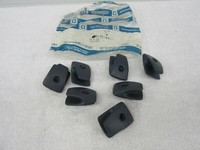About
All feedback (44)
- morrissalesv4 (2995)- Feedback left by buyer.More than a year agoVerified purchaseGood buyer, prompt payment, valued customer, highly recommended.
- e-city2008 (32961)- Feedback left by buyer.More than a year agoVerified purchaseGood buyer, prompt payment, valued customer, highly recommended.
- bestfindsforu (3436)- Feedback left by buyer.Past yearVerified purchase.:*¨¨*:.WONDERFUL*¨¨*RECOMMEND*¨¨*BUYER .:*¨¨*:.
- volksbolts (27359)- Feedback left by buyer.More than a year agoVerified purchaseMany thanks from Volksbolts Hope to deal with you again.
- metriwrenc_0 (389)- Feedback left by buyer.More than a year agoVerified purchaseGreat ebayer. Thanks for buying.
- ricjo6605 (117)- Feedback left by buyer.More than a year agoVerified purchaseGreat buyer fast payment ❤️
Reviews (3)

Dec 07, 2021
High quality, they also work on earlier (1989, etc) Chevy Caprices
I bought these coat hooks because I thought I had lost one of the original hooks for a 1989 Chevy Caprice Wagon when I was having the headliner replaced. I could not find the original hooks being sold anywhere, so I bought these hooks even though they're technically not correct, thinking that I could always modify them to fit if necessary. However, they ended up being better than the original hooks, and I used them in place of the original hooks even though I found the original lost hook shortly after the new hooks arrived. The original hooks have a very sharp protrusion that is designed to dig into the headliner and fit into a small indentation in the ceiling underneath. This stops them from rotating since only one screw holds them in place. However, these new hooks have a much blunter protrusion in exactly the same place, so I think they are much less likely to damage the headliner over time. They otherwise fit perfectly, although they have a larger base and the appearance is different. If you don't care about the look of absolute original authenticity, I would buy these hooks even for earlier 1989-vintage Caprices.

Jan 25, 2024
Perfect fit and well packaged for shipment.
I've not yet installed the intake manifold gasket, but it appears to be a perfect fit after matching it with the new intake manifold I'm planning to install on a 1973 SAAB Sonett III. The gasket came very well packaged with a stiff backing to protect it during shipment.

Feb 11, 2022
Seems to be excellent for digitally copying DAT and Minidisc recordings to a hard drive.
I am using this device to copy privately-made DAT and Minidisc live/LP recordings to a MacBook Pro hard drive via toslink optical connections. I am doing this to avoid any intermediate D/A and A/D conversions between the DAT or Minidisc source and the hard drive target in order to preserve the original audio quality as much as possible. In this regard it seems to be working perfectly, although there are some considerations to make because of the digital streams that are involved.
I configured the UA-1EX device to select the digital optical source via a dipswitch setting on the underside, then I connected one end of a toslink cable to the optical digital input connector on the UA-1EX using an intermediate mini-toslink to toslink connector which I purchased separately, and the other end of the cable to a LiNKFOR toslink switch which I use to select either my Sony DTC-790 DAT deck or my Sony MDS-JE520 Minidisc deck as the source. On my MacBook Pro I am using the Sound Studio recording application.
With this setup I seem to be making very high quality hard drive copies of my DAT and Minidisc recordings. There are some issues to consider -
1) Because the incoming signal to the MacBook Pro is digital, there is no facility on the UA-1EX nor in Sound Studio to adjust the volume of the signal being recorded. Sound Studio simply accepts what it gets via the UA-1EX and writes it to hard disk. Any adjustment to the volume setting has to be done with a post-processing filter in Sound Studio. If you playthrough a very loud source to the MacBook Pro speakers while recording you might hear distortion due to speaker clipping, but it seems that otherwise the recording on the hard drive isn't corrupted. It sounds fine in this regard once the appropriate volume adjustment is made via post-processing.
2) Most if not all of my DAT recordings were made at the low speed setting so that I could record complete Saturday Matinee operas broadcast by the NY Metropolitan Opera on a single tape. When recording these DAT tapes via the above setup I found that the tempo of the sound being recorded was too fast by roughly 1/3. Announcer Peter Allen sounded like Daffy Duck. Again, this is probably due to the digital stream that is involved, with the conversion from a 32k stream to a 48k stream failing somewhere. As with the volume issue above I could find no way to correct for this during recording, so I devised a "Pitch and Tempo" post processing filter in Sound Studio to correct for this after the recording is complete. I lock Tempo and Pitch in the settings window, then adjust the Tempo to 72% (which makes the Pitch -568, somehow) then apply it to the entire recording. I manually compared the relative pitch of the source and copy to arrive at this setting - intuitively I would have guessed that 67% would be correct but this resulted in the pitch sounding too flat.
I'm not sure if you can buy the UA-1EX new any more, since there might not be any inherent inhibitions to making very high quality recordings of copyrighted material (which I have no intention of doing). However, if your recording quests are sincere and legitimate, and you have a requirement similar to mine, I recommend that you find this thing used wherever you can and buy it.
